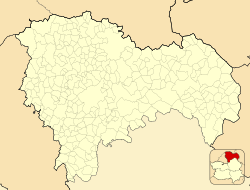Alovera facts for kids
Quick facts for kids
Alovera
|
|||
|---|---|---|---|
 |
|||
|
|||
| Country | |||
| Autonomous community | Castile-La Mancha | ||
| Province | Guadalajara | ||
| Municipality | Alovera | ||
| Area | |||
| • Total | 13,65 km2 (527 sq mi) | ||
| Population
(2018)
|
|||
| • Total | 12,570 | ||
| • Density | 893.48/km2 (2,314.1/sq mi) | ||
| Time zone | UTC+1 (CET) | ||
| • Summer (DST) | UTC+2 (CEST) | ||
Alovera is a town in Spain. It is located in the province of Guadalajara. This province is part of the Castile-La Mancha region. In 2015, about 12,247 people lived there.
Contents
A Look at Alovera's History
Alovera has a long and interesting past. We know people lived here many centuries ago. Discoveries show that both Roman and Visigothic people once called this area home.
Ancient Discoveries in Alovera
We have found clues about early settlements. These clues help us understand who lived here before.
Roman Times in Alovera
In 1999, during work on St. Michael's Church, something amazing was found. It was a Roman cupae, which is a type of tomb. This tomb was from the 1st or 2nd century.
Experts studied the writing on the tomb. It said it was for "Pompeyo Fusco, 60 years old." His wife, Antonia Melusa, had it made for him. This shows a Roman settlement existed in Alovera. People also think a column base in the church was once part of a Roman villa.
Visigothic Era in Alovera
We also know about a Visigothic settlement in Alovera. This is thanks to two special brooches. These brooches are called fibulas. They are on display at the National Archaeological Museum in Madrid.
These fibulas were made in the 6th century. They used a special art technique called cloisonné. This technique involves setting colored glass or gems into metal outlines.
Alovera in Later Centuries
The first written records mentioning Alovera are from the 16th century. At that time, Alovera was a farming community. Its lands belonged to nearby monasteries.
Building St. Michael's Church
In the 16th century, the St. Michael's Church was built. Master Nicolás de Ribero led the construction. He had help from Juan de Buerga and Juan Ballesteros. The church was finished in 1690.
The church has three main sections, a bell tower, and an entrance area. The main altar was built in the 17th century. It was created by Juan, Pedro, and Francisco González. There is also another altar dedicated to St. Gregory. A painting called "Pieta" by Willem Key is in the church's sacristy.
Becoming a 'Villa'
In 1626, King Felipe II gave Alovera the title of villa. This was an important title. It meant the town had certain rights and importance.
After this, the "Villahermosa de Alovera" was sold. It was bought by Lorenza de Sotomayor. She became the marquess of Alovera. Even today, there is still a marquess of Alovera.
See also
 In Spanish: Alovera para niños
In Spanish: Alovera para niños







